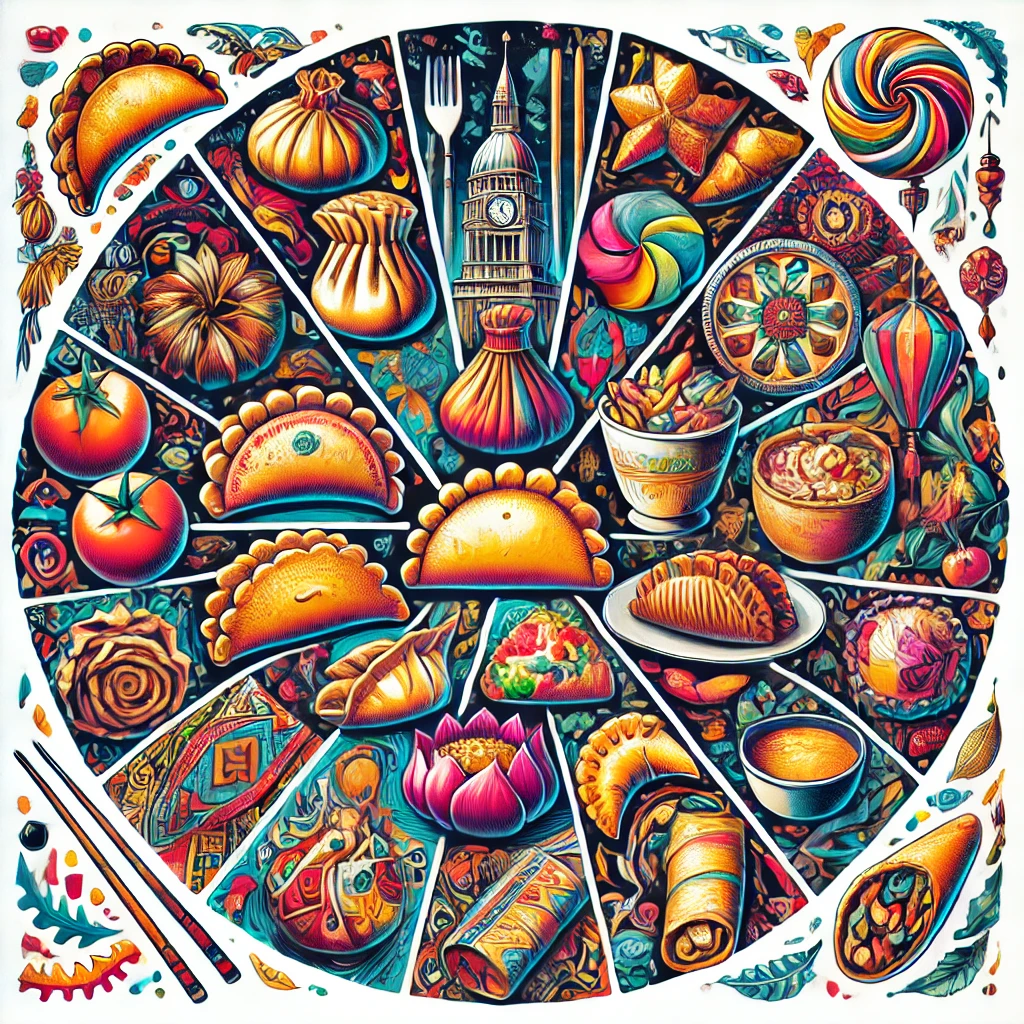The functional beverage space is evolving—fast. What started with protein shakes and vitamin waters has transformed into a sophisticated market…
Pocket Foods Around the World: A Cultural and Culinary History
Pocket foods are the unsung heroes of culinary innovation. These portable, flavorful snacks have been solving the age-old problem of hunger on the go since, well, forever. These edible pouches of joy have evolved in various forms worldwide, each culture adding its unique twist. Join me on a fun and flavorful journey through the history and cultural significance of some iconic pocket foods. Let’s dig in!
Dumplings: Ancient China (206 BCE – 220 CE)
Our culinary journey kicks off in ancient China, during the Han Dynasty, where dumplings (jiaozi) were first concocted. Picture this: a physician named Zhang Zhongjing, known as the “Dumpling Daddy,” crafted these delightful dough pockets to combat frostbite in his village. He filled them with warming ingredients like lamb and herbs, creating the perfect winter snack that doubled as a remedy.
Cultural Importance:
In ancient China, dumplings weren’t just for eating; they were for bonding. Making dumplings was a family affair, especially during Chinese New Year. Shaped like gold ingots, they symbolized wealth and prosperity. Imagine biting into a tiny, delicious piece of treasure.
Modern Significance:
Today, dumplings are a staple in Chinese cuisine and a global favorite. Restaurants like Din Tai Fung have turned dumplings into a gourmet experience. There are dumpling festivals, where people indulge in these delightful parcels by the dozen, proving that good things really do come in small packages.
Samosas: Middle East to India (13th-14th Century)
Next, we head to the Middle East, the original land of “sambosas.” These triangular treats migrated to India during the 13th and 14th centuries, where they were transformed into the spicy, crispy samosas we know and love today. Think of samosas as the spicy love child of Middle Eastern and Indian culinary traditions.
Cultural Importance:
In India, samosas are the life of the party. They’re the star of every tea-time snack, street food stall, and festive celebration. Pair them with a hot cup of chai, and you have a match made in snack heaven.
Modern Significance:
Samosas have gone global, appearing in menus from Mumbai to Manhattan. Chains like Bikanervala and Haldiram’s in India have made a name for their perfect samosas, while in the UK, they’re practically a staple. The global samosa obsession is real.
Tamales: Ancient Mesoamerica (Pre-Columbian Era)
Tamales take us back to the pre-Columbian era, with roots in Aztec and Mayan civilizations. Made from masa (corn dough) and filled with meats, cheeses, or chilies, tamales were the original power bars for warriors, hunters, and travelers. They’re like the ancient energy bar, but way tastier.
Cultural Importance:
In Mexico, tamales are a family and community affair, especially during Christmas and Dia de los Muertos. Making tamales is a labor of love that brings people together, symbolizing unity and tradition.
Modern Significance:
Tamales are still a staple in Mexican cuisine and have crossed borders into the United States, where restaurants like Tamales Elena y Antojitos serve them up with pride. Tamale festivals are a thing, proving that this ancient snack still holds a special place in our hearts and stomachs.
Empanadas: Spain to South America (16th Century)
Empanadas, those delightful pastries from Spain and Portugal, found their way to South America in the 16th century. Each country added its flair: Argentina filled them with beef, Chile with seafood, and so on. Empanadas are like the ultimate food passport, stamped with diverse flavors.
Cultural Importance:
Empanadas are a symbol of cultural fusion, reflecting the rich history of Latin America. They’re a must-have at festivals, family gatherings, and even political rallies. They’re the unofficial food of unity and celebration.
Modern Significance:
Empanadas have conquered the world, with dedicated restaurants like La Fabrica del Taco in Buenos Aires and The Empanada Kitchen in the US serving them up. Their versatility and deliciousness make them a global snack superstar.
Pasty: Cornwall, UK (17th-18th Century)
The Cornish pasty, popular in Cornwall during the 17th and 18th centuries, was the original lunchbox meal for miners. Filled with meat, potatoes, and vegetables, these hearty pastries were designed to be eaten with dirty hands, with the crust acting as an edible handle. Ingenious, right? And let’s clear something up right away: a pasty is not the same as a pastry. The former is a savory, hearty meal, while the latter is usually sweet and delicate. Don’t let the similar spelling fool you!
Cultural Importance:
The pasty is a symbol of Cornish heritage and practicality. It’s so iconic that it has Protected Geographical Indication (PGI) status in Europe. Eating a pasty is like taking a bite of Cornish history.
Modern Significance:
Today, Cornish pasties are enjoyed worldwide. Bakeries like The Cornish Bakery and The Cornish Pasty Co. have perfected the art of the pasty, offering traditional and innovative fillings that keep this age-old snack fresh and exciting.
Calzones: Naples, Italy (18th Century)
From the bustling streets of Naples in the 18th century comes the calzone, the portable cousin of pizza. Imagine pizza, but folded in half to trap all the cheesy, meaty goodness inside. It’s like a pizza pocket, but way classier.
Cultural Importance:
Calzones were designed for workers who needed a meal on the go. They embody the Italian knack for turning simple ingredients into something extraordinary. They’re a street food staple, reflecting the ingenuity of Italian cuisine.
Modern Significance:
Calzones have made their way into Italian restaurants around the globe. From local pizzerias to big chains like Papa John’s, everyone loves a good calzone. They’re the ultimate grab-and-go gourmet meal.
Pierogi: Poland (19th Century)
Pierogi, those delightful Polish dumplings, have been around since the 19th century. Filled with potatoes, cheese, meat, or fruit, they’re a comfort food favorite. Think of them as the Eastern European answer to dumplings, with a hearty twist.
Cultural Importance:
Pierogi are a staple at Polish family gatherings and holidays. They represent comfort and tradition, often made in large batches with love and care. Eating pierogi is like getting a warm hug from your Polish grandma.
Modern Significance:
Pierogi have gained international fame, with restaurants like Pierogi Grill in the US offering a taste of Polish comfort. Pierogi festivals are a thing, where people gather to celebrate and devour these delicious dumplings.
Stuffed Cabbage Rolls: Eastern Europe (19th Century)
Stuffed cabbage rolls, known as “golabki” in Poland and “sarma” in the Balkans, have been a beloved dish in Eastern Europe since the 19th century. Picture tender cabbage leaves wrapped around a filling of minced meat, rice, and spices, simmered in tomato sauce. It’s like a warm, savory hug.
Cultural Importance:
Stuffed cabbage rolls are a staple at family gatherings and celebrations, symbolizing home and tradition. They reflect the resourcefulness of Eastern European cuisine, turning simple ingredients into something hearty and satisfying.
Modern Significance:
Stuffed cabbage rolls are still popular today, with restaurants like Veselka in New York City offering authentic Eastern European dishes. They’re a testament to the enduring appeal of comfort food.
Egg Rolls: China to America (20th Century)
Egg rolls, believed to have originated in China, became a hit in the United States in the mid-20th century. These crispy rolls, filled with vegetables, meat, or seafood, are the crunchy cousins of spring rolls. They’re the snack equivalent of a high five.
Cultural Importance:
In China, spring rolls and egg rolls are enjoyed during festivals and celebrations, symbolizing prosperity. In the US, egg rolls have become a beloved appetizer, reflecting the blending of Chinese and American culinary traditions.
Modern Significance:
Egg rolls are a staple in Chinese-American cuisine, found in restaurants from coast to coast. Chains like Panda Express and local takeouts have made egg rolls a beloved snack, proving that crunchy and delicious never goes out of style.
Conclusion
Pocket foods are more than just convenient snacks; they are a reflection of cultural ingenuity and adaptation. From the dumplings of ancient China to the empanadas of South America, each pocket food tells a story of migration, trade, and culinary evolution. These foods have stood the test of time because they meet fundamental human needs: portability, preservation, and, most importantly, flavor.
Whether you’re enjoying a samosa in India or a tamale in Mexico, you’re partaking in a tradition that spans centuries and continents. So, next time you bite into a delicious pocket food, take a moment to appreciate the rich history and cultural significance that comes with every bite.
Sources:
- “The Oxford Companion to Food” by Alan Davidson
- “Street Foods” by Bruce Kraig and Colleen Taylor Sen
- Wikipedia
- History of Samosa
- Calzone Origins
- Empanada History
- [Dumplings in China](https://www.chinahighlights.com/travel







